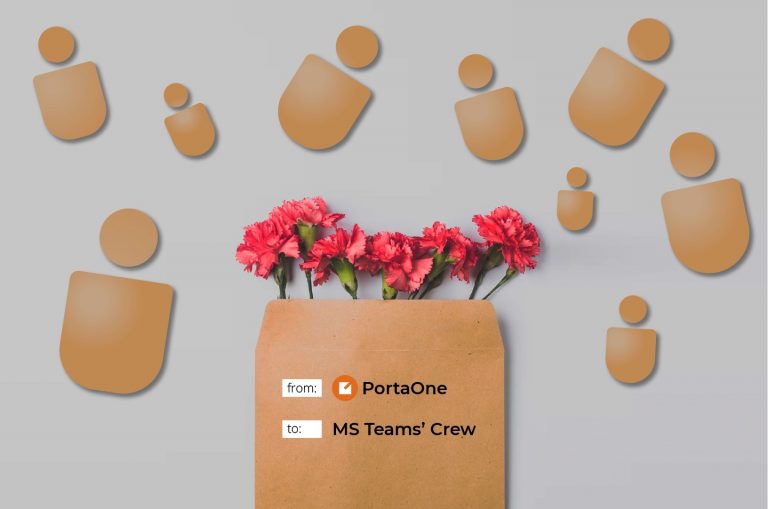Microsoft is making headlines yet again. So much so that World of Warcraft might just use the Android wing at the Googleplex headquarters as a future dystopia set. Moreover, $MSFT has now officially outplayed $GOOGL on the UCaaS battlefield, to the point where, last October, Gartner recognized Microsoft as the UCaaS leader. The liberal manner in which Microsoft Teams PBX approaches gateways has attracted a lot of players. And many of them were, to put it in technical terms, pissed off by what our highly respected competitor Cisco did to BroadWorks.
At PortaOne, we saw this perfect storm coming more than two decades ago, when we were experimenting with what became Skype for Business. Let’s be frank: Google is putting up a tough fight for Redmond with its WebRTC. And, yes, we are vesting our eggs in all baskets. Still, Teams turned out to be what many SMB customers wanted: simple, intuitive, and scalable.
Slack might be great with texts, group chats, and automation. But its current voice technology stack has a lot of room for improvement. (That’s not even to mention all the other woes.) And, sure, Discord is excellent with all three (text, voice, and video)… but when was the last time you allowed folks in your office to use “an app for gamers and by gamers”?
How Did Microsoft Teams PBX Begin at PortaOne?
“Being a devoted linuxoid, I was initially skeptical of Microsoft Teams,” says Andriy Zhylenko, CEO of PortaOne. “The story of how Microsoft acquired Skype, spent years figuring out what to do with it, then created (in 2014) and then killed (in 2017) Skype for Business gave me sufficient grounds for my skepticism.”
But when COVID-19 hit, Andriy soon changed his mind. “During the lockdown, the kids were doing online classes via Microsoft Teams. They have Chromebooks,” he says. “So, I thought initially, here it comes: the clash of the titans. But Teams proved to work via Chrome without a single glitch. The sound and video quality were decent, thanks to WebRTC. The software adapted well to connectivity spikes. The teachers had powerful controls during the conversations. I was impressed. Microsoft had finally found their way in cloud voice and video.”
Think Different
Since its inception, Teams has been a radically different Microsoft product. Armed with Slack and HipChat as a model, Microsoft collected its best talent at a fruit farm in Hawaii. Brian MacDonald, a member of the original Outlook mail client team, led the effort. Teams uses GitHub’s Electron, combining Chromium with Node.js. This approach allows the software to run fast on the various competitor platforms, including Linux, Chrome OS, and Mac OS.
Empowering Teams with a PBX Solution
Andriy’s realization came at an opportune moment. Right around that time, our sales team had started getting a lot of requests for a Teams integration with PortaSwitch.
This success with Teams coincided with the Metaswitch acquisition. See, first of all, Microsoft badly needed “back-end” telephony features for Teams.
Source: a post on the Cavell Group Blog by Patrick Watson
Secondly, cloud telephony and cloud PBX are logical directions for Azure and 365. Teams had gathered 145 million users as of Q1 2021 (compare that to Slack’s “600,000+ organizations”). The addition of cloud telephony is hitting Slack in its weakest spot.
Microsoft as Telco
Integrating Metaswitch puts Microsoft in the same league (or even higher) with the major equipment and telco vendors: Cisco, Ericsson, Huawei – all organizations that are now direct competitors with Microsoft. The recent acquisition of Affirmed Networks (a vendor of network core elements) hints that the game is on, and Microsoft wants to have a complete infrastructure set under its control. Now, it seems, it is outstepping the traditional telco vendor mafia by using the late-comer advantage and jumping directly into the cloud.
And then you have the “endspiel” against the large telcos. (Spoiler alert… this is going to come up again later. Just a heads-up for when you get to the “thousand cuts” section.)
Microsoft Teams Plus PBX at PortaOne – A Tale of Gradual Evolution
Here at PortaOne, we started our PBX evolution with a proof-of-concept of sorts. And that was all thanks to our client A1, which provides VoIP, web hosting, online backup, and other solutions powered by PortaSwitch in the Netherlands. They were among the earliest adopters, and as early as December 2019 they had created a DIY solution that integrated Microsoft Teams with “standard” VoIP PBX.
A1 created a direct routing between PortaSwitch and Microsoft Teams: the end user could choose to pick up an inbound call either through the Teams app or through their PortaSwitch-powered VoIP phone. This offered more flexibility in terms of software licensing and complex call routing scenarios. (Think: autoresponders or IVRs.)
Boom! (And Also TeamMate)
Then, in 2020, our UK client Boom approached us with several exciting ideas for Microsoft Teams PBX integrations based on PortaSwitch. As you read this, Boom is working on their solution, and we’ll be happy to welcome it to Add-on Mart as soon as it’s ready.
And there’s more to come. Recently, we completed partnership talks with TeamMate Technology, which allows customers to connect the Teams environment with existing hosted PBX. TeamMate created a connector that allows you to, in their words, “integrate any existing PBX, SIP Trunk, and many SMS gateways to Microsoft Office 365.”
The Star Player Technologies
Now, let’s take a moment to dive into a few brief explainers for some of the key technologies that are supporting this integration-slash-evolution. First up…
Microsoft Graph API
Graph API allows you to perform different actions with users who have a Microsoft account. You can also interact with user groups. In some part, Graph is Microsoft’s response to Facebook Graph. Redmond released “their” Graph in 2015, two years after Mr. Zuckerberg… albeit with much better publicity. (Hello, Cambridge Analytica.)
Hello, Old Good Active Directory!
There are some obvious benefits of Graph for a Microsoft Teams PBX integration. One is the ability to perform various authorized operations with user credentials via the Azure Active Directory. Yes, that’s the new & fancy name for an old, good, and powerful tool that Redmond first introduced in Windows Server 2003.
Another benefit is getting a list of the user’s “most frequent contacts.” Just imagine the UX miracles this could do for a hunt group or for customized IVRs, not to mention the various simplified authentication scenarios. Our customers get access to these Graph perks via the TeamMate application and TeamMate Connector.
Microsoft PowerShell
According to its well-written documentation, PowerShell is “a cross-platform task automation solution made up of a command-line shell, a scripting language, and a configuration management framework.” And Microsoft really does mean “cross-platform” here: it’s good with Windows, Linux, and macOS. PowerShell offers a dedicated module for Teams, and boosts that with a how-to guide. (A guide that also acts as a kind of AMA for developers working with this module, as it turns out.) Teams PowerShell lets you create and manage teams (duh! 😂), policies (a “group of settings that can apply granularly to individual users”), and configurations.
For example, our partner TeamMate uses PowerShell for various automation tasks within a subscriber’s Teams environment. On our part, PortaOne is automation-solutions agnostic. Still, we have a strategic partnership with Dell Boomi for a more “low-code” approach to creating data flows. For instance, in 2021, Boomi enabled Xero and HubSpot integrations for PortaSwitch.
Azure and Teams Phone
Want the basic game plan? Here’s the Teams Phone course of action that Microsoft currently advises telcos to follow:
- Interested telcos should register with Operator Connect.
- After that, they become listed in the Operator Directory.
- Once listed, any Teams customer can place calls via the registered telco via Teams Phone.
Microsoft even has Teams Phone guidance for small and medium businesses, should you need a more detailed explanation. So it’s that simple, right? Well, as with any situation involving a multi-billion-dollar corporation: no, it is not. And that’s why PortaOne (and PortaPhone) could be a great addition on top of Teams and Teams Phone.
Teams with PortaOne vs. Teams Phone via Azure
And now (as the old local joke goes): the nuances. “Teams Phone is a great solution when you have 10 to 30 subscribers with basic use case scenarios,” explains Andriy Zhylenko. The moment you start having more people, you will discover the skyrocketing costs. Also, as soon as you need more complex use cases (for example, call forwarding with separate policies for landline and mobile or for auto-attendants), you will either come across the additional licenses that you need to procure or your dev team will need to do additional coding.”
To help you avoid all that, Andriy recommends choosing a “best of both worlds” approach. How do you do that? Supply the end users (at least those who need it) with the proper UX for the Teams client on their PC/laptop/phone, with the power of advanced configuration for the cloud PBX service that’s available on the PortaSwitch back end.
“This gives a CSP the ability to quickly add new features on the PortaSwitch side. For example, there’s the ability to purchase international phone numbers from a new provider, or the custom programming of voice scenarios via API of CPaaS,” says Andriy. “Also, having access to a full-fledged VoIP PBX means that an end user has the freedom to use any physical SIP device – whether that’s high-end conferencing equipment or a SIP-enabled front-door intercom such as DoorBird.”
PortaPhone for Teams
After we launched PortaPhone in partnership with WebTrit, our clients started receiving integration requests from local government agencies and NGOs – their end users. The problem with existing Microsoft phone-calling tariffs is that they are expensive. (Yes, the same problem as you’ll find with any tariffs, at least from the viewpoint of the end user.) Understanding the calling plans that Microsoft offers for Teams is a risky gamble. (For more on all the nuances and intricacies of Teams licensing and calling plans, check out this great blog post by Tom Arbuthnot.)
Luckily, Microsoft still left open direct routing, which we discovered several years ago while working with A1. But, as of December 2021, we started to see the Microsoft Teams PBX team implementing a number of changes to direct routing. Today, the future of this great feature is uncertain. Worse, there’s an unconfirmed rumor that Microsoft is stopping its certification of Session Border Controllers for Direct Routing. That’s one of the reasons why PortaOne isn’t on the list.
The Teams Store Drama
Now it’s time to add even more drama to this story. See, we recently applied to the Microsoft Teams Store for PortaPhone, and the app review is still pending as of the date we posted this story. (That’s over two months from when we applied!) When we looked into the reasons for the delay, it turns out that PortaPhone was lacking the functionality to allow calls to a few local numbers in India. Apparently, that’s where the PortaPhone app is getting tested right now.
“Bring Your Own Operator,” or How Microsoft Is Planning to Take Over the Large Telcos by a Thousand Cuts
So, now a bit of bad news: it now looks like Microsoft Teams with PBX will eventually kill the “business telephony” of the traditional large telcos… or at least force those telcos into “partnerships.” That means the future role of telcos might be limited to providing basic data connectivity, along with a few niches that Microsoft is not interested in implementing within their own core platform. But here’s the good news: Microsoft is planning to do all of that indirectly. The change will come via the ecosystem of local partner operators and smaller resellers/virtual operators.
And what does this all mean for our PortaOne customer niche? It means that there is an opportunity window…
That is to say, all of those resellers are going to have to find a way to stay competitive… and that means we are about to see a parade of various CRM integrations, voice2text analytics tools, geodata-based call scenarios, call automation, and so on and so on. And? PortaOne can help you turn your Microsoft Teams PBX value proposition into something truly fruity.
What It Means for You
The bottom line of all this? Here it is in three points:
- Microsoft managed to build an outstanding team collaboration solution. (Once again, hello, Teams.) We love Teams. And what we love even more is Microsoft finally getting their partnership ecosystem right (again, after so many years).
- Yes, Redmond will now be leveraging their multi-million-strong army of active users to claim their synergy benefits in PBX and reframe the market.
- And, yes, this news is actually good for solution providers and telcos. At least for the ones that are flexible enough to adapt their technology stack to these changes and maneuver their way into new revenue horizons.
If you are lighting out on this interesting and inspiring climb, PortaOne is ready to be your sherpa and your guide along the way. Please inquire with our sales team to find out more.











